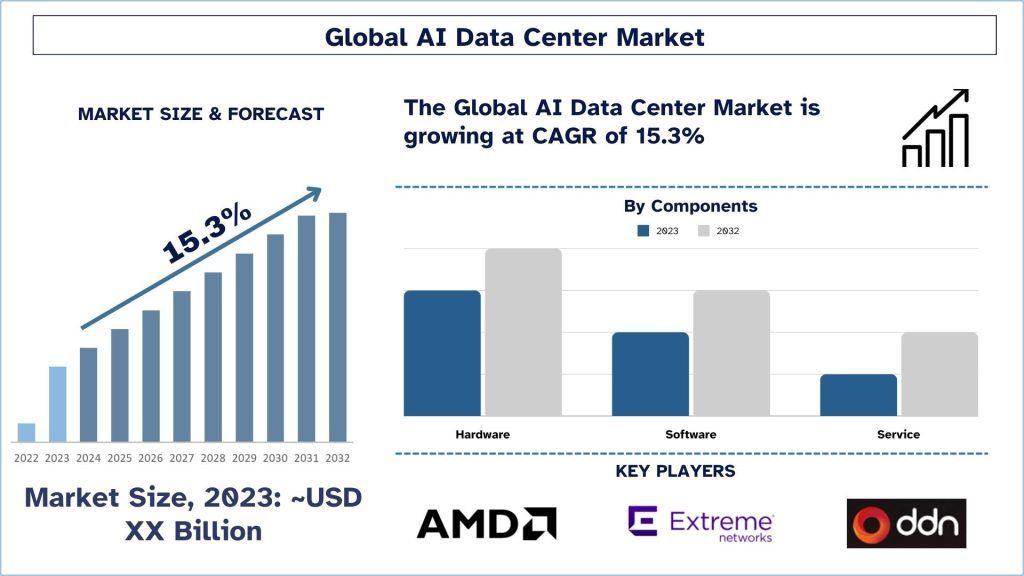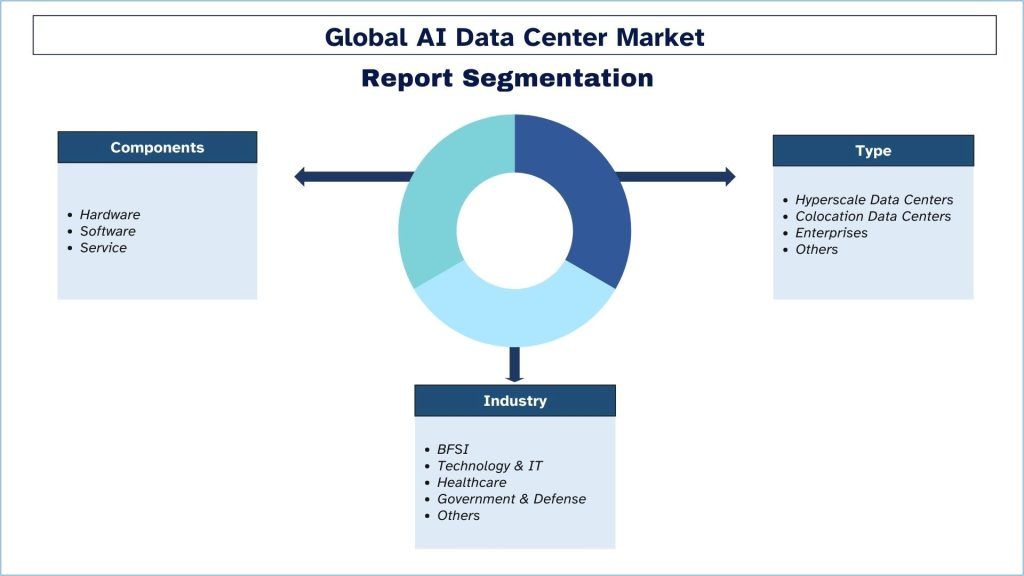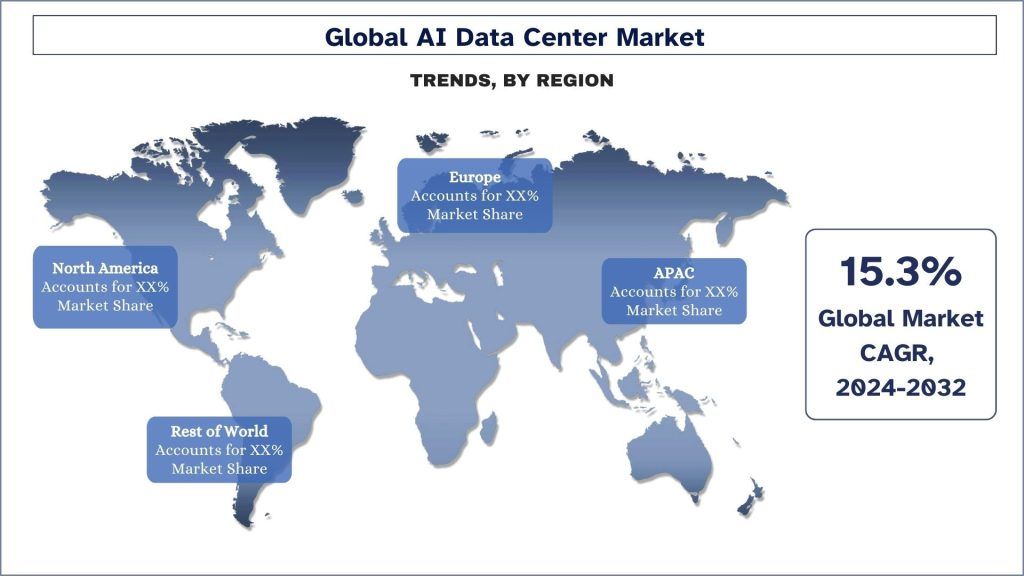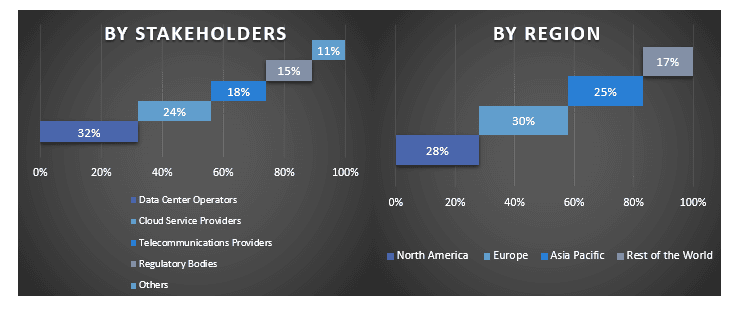 글로벌 AI 데이터 센터 시장 규모 및 예측
글로벌 AI 데이터 센터 시장 규모 및 예측
글로벌 AI 데이터 센터 시장은 2023년에 XX억 달러로 평가되었으며, 데이터 생성의 기하급수적인 증가로 인해 이러한 데이터를 효과적으로 저장, 처리 및 분석하기 위한 고급 데이터 센터가 필요하므로 예측 기간(2024-2032) 동안 약 15.3%의 강력한 연평균 성장률(CAGR)로 성장할 것으로 예상됩니다.
AI 데이터 센터 시장 분석
AI 데이터 센터 시장은 AI 요구 사항에 최적화된 컴퓨팅, 스토리지 및 네트워크와 같은 요소를 통해 AI 컴퓨팅을 지원하기 위해 구축된 시설 및 시스템으로 정의할 수 있습니다. 이러한 동인에는 의료 및 금융과 같은 부문에서 인공 지능의 사용이 증가하는 것이 포함됩니다. 또한 빅 데이터와 IoT의 채택이 증가함에 따라 방대한 양의 데이터를 관리할 수 있는 데이터 센터에 대한 수요가 창출되고 있으며, 이는 AI 데이터 센터 시장에 긍정적인 시장 성장 기회를 창출할 것으로 예상됩니다.

글로벌 AI 데이터 센터 시장 동향
이 섹션에서는 당사 연구 전문가 팀이 발견한 바와 같이 글로벌 AI 데이터 센터 시장의 다양한 부문에 영향을 미치는 주요 시장 동향에 대해 설명합니다.
하이퍼스케일 데이터 센터 부문이 산업을 변화시키고 있습니다
하이퍼스케일 데이터 센터 부문은 AI 관련 워크로드를 지원하는 데 필요한 처리 기능과 유연성을 제공하기 때문에 AI 데이터 센터의 글로벌 시장에 대한 주요 기여자 중 하나입니다. Amazon, Google, Microsoft에서 운영하는 이러한 데이터 센터는 수천 대의 서버를 보유하고 AI 기술에서 생성된 빅 데이터를 제어하도록 구축되었습니다. 리소스 관리의 유연성과 GPU 및 TPU를 포함한 최신 AI 하드웨어 지원으로 인해 하이퍼스케일 데이터 센터를 통해 기업은 어려운 AI 관련 작업을 보다 효과적으로 수행하고 산업 전반에 걸쳐 혁신을 주도하여 효율성을 높이고 비용을 절감할 수 있습니다.
북미는 예측 기간 동안 시장을 지배할 것으로 예상됩니다.
북미 AI 데이터 센터 시장은 의료, 금융, 자동차 등 산업에서 고급 AI 솔루션의 채택이 증가함에 따라 빠른 속도로 성장할 것으로 예상됩니다. 생성되는 데이터 양의 급격한 증가와 즉각적인 데이터 분석의 필요성은 AI 워크로드를 지원하고 계산 밀도를 향상시키기 위해 설계된 새로운 데이터 센터의 배포를 촉진하고 있습니다. 시장의 주요 업체 중 일부는 효율성과 속도를 높이기 위해 머신 러닝, 에지 컴퓨팅 및 더 나은 냉각 솔루션과 같은 고급 기술의 채택을 강조해 왔습니다. 또한 클라우드 서비스 및 하이브리드 데이터 센터 기술의 채택 증가는 시장 성장에 박차를 가하고 기술 혁신 및 투자를 위한 핵심 지역입니다.

글로벌 AI 데이터 센터 산업 개요
글로벌 AI 데이터 센터 시장은 여러 글로벌 및 국제 시장 플레이어와 경쟁적입니다. 주요 업체는 파트너십, 계약, 협업, 신제품 출시, 지리적 확장, 인수 합병 등 시장 입지를 강화하기 위해 다양한 성장 전략을 채택하고 있습니다. 시장의 주요 업체로는 Advanced Micro Devices, Inc., Cisco Systems, Inc., Cohesity, Inc., DDN Group, Dell Inc., Extreme Networks, Hewlett Packard Enterprise Development LP, Hitachi Vantara LLC, Intel Corporation 및 NVIDIA Corporation이 있습니다.
글로벌 AI 데이터 센터 시장 보고서 범위
보고서 속성 | 세부 정보 |
기준 연도 | 2023 |
예측 기간 | 2024-2032 |
성장 모멘텀 | 연평균 성장률(CAGR) 15.3%로 가속화 |
2023년 시장 규모 | XX억 달러 |
지역 분석 | 북미, 유럽, 아시아 태평양, 기타 세계 |
주요 기여 지역 | 북미는 예측 기간 동안 시장을 지배할 것으로 예상됩니다. |
주요 국가 | 미국, 캐나다, 독일, 영국, 스페인, 이탈리아, 프랑스, 중국, 일본 및 인도 |
프로필 회사 | Advanced Micro Devices, Inc.; Cisco Systems, Inc.; Cohesity, Inc.; DDN Group; Dell Inc.; Extreme Networks; Hewlett Packard Enterprise Development LP; Hitachi Vantara LLC; Intel Corporation; And NVIDIA Corporation |
보고서 범위 | 시장 동향, 동인 및 제약; 수익 추정 및 예측; 세분화 분석; 수요 및 공급 측면 분석; 경쟁 환경; 회사 프로필 |
다루는 세그먼트 | 구성 요소별; 유형별; 산업별; 지역/국가별 |
이 보고서를 구매해야 하는 이유:
- 이 연구에는 인증된 주요 업계 전문가가 확인한 시장 규모 및 예측 분석이 포함되어 있습니다.
- 이 보고서는 전체 산업 성과를 한눈에 간략하게 검토합니다.
- 이 보고서는 주로 주요 비즈니스 재무, 유형 포트폴리오, 확장 전략 및 최근 개발에 중점을 둔 주요 업계 동료에 대한 심층 분석을 다룹니다.
- 산업에 만연한 동인, 제약, 주요 동향 및 기회에 대한 자세한 조사.
- 이 연구는 다양한 부문에 걸쳐 시장을 포괄적으로 다룹니다.
- 산업에 대한 심층적인 지역 수준 분석.
사용자 정의 옵션:
글로벌 AI 데이터 센터 시장은 요구 사항 또는 기타 시장 부문에 따라 추가로 사용자 정의할 수 있습니다. 이 외에도 UMI는 귀하가 귀하의 비즈니스 요구 사항을 가지고 있을 수 있음을 이해하므로 귀하의 요구 사항에 완전히 적합한 보고서를 얻으려면 언제든지 저희에게 연락하십시오.
목차
글로벌 AI 데이터 센터 시장 분석 (2024-2032)을 위한 연구 방법론
글로벌 AI 데이터 센터 시장의 과거 시장 분석, 현재 시장 추정, 미래 시장 예측은 주요 지역에서 글로벌 AI 데이터 센터의 채택을 분석하고 만들기 위해 수행된 세 가지 주요 단계였습니다. 과거 시장 수치를 수집하고 현재 시장 규모를 추정하기 위해 광범위한 2차 연구가 수행되었습니다. 둘째, 이러한 통찰력을 확인하기 위해 수많은 조사 결과와 가정이 고려되었습니다. 또한 글로벌 AI 데이터 센터 시장의 가치 사슬 전반에 걸쳐 업계 전문가들과 광범위한 1차 인터뷰가 진행되었습니다. 1차 인터뷰를 통해 시장 수치를 가정하고 검증하기 위해, 전체 시장 규모를 예측하기 위해 하향식/상향식 접근 방식을 사용했습니다. 이후 시장 세분화 및 데이터 삼각 측량 방법을 채택하여 해당 산업의 세분 시장 및 하위 세분 시장의 시장 규모를 추정하고 분석했습니다. 자세한 방법은 아래에 설명되어 있습니다.
과거 시장 규모 분석
1단계: 2차 출처에 대한 심층 연구:
연례 보고서 및 재무 제표, 실적 발표, 보도 자료 등과 같은 회사 내부 자료와 저널, 뉴스 및 기사, 정부 간행물, 경쟁사 간행물, 부문 보고서, 타사 데이터베이스 및 기타 신뢰할 수 있는 간행물을 포함한 외부 출처를 통해 글로벌 AI 데이터 센터 시장의 과거 시장 규모를 얻기 위해 자세한 2차 연구가 수행되었습니다.
2단계: 시장 세분화:
글로벌 AI 데이터 센터 시장의 과거 시장 규모를 확보한 후, 주요 지역의 다양한 세분 시장 및 하위 세분 시장에 대한 과거 시장 통찰력과 점유율을 수집하기 위해 자세한 2차 분석을 수행했습니다. 주요 세분 시장은 구성 요소, 유형, 산업 및 지역과 같이 보고서에 포함되어 있습니다. 또한 해당 지역의 테스트 모델의 전반적인 채택을 평가하기 위해 국가 수준 분석을 수행했습니다.
3단계: 요인 분석:
다양한 세분 시장 및 하위 세분 시장의 과거 시장 규모를 확보한 후, 글로벌 AI 데이터 센터 시장의 현재 시장 규모를 추정하기 위해 자세한 요인 분석을 수행했습니다. 또한 구성 요소, 유형, 산업 및 글로벌 AI 데이터 센터 시장 지역과 같은 종속 변수 및 독립 변수를 사용하여 요인 분석을 수행했습니다. 글로벌 AI 데이터 센터 시장의 주요 파트너십, 인수 합병, 사업 확장 및 제품 출시를 고려하여 수요 및 공급 측면 시나리오에 대한 철저한 분석이 수행되었습니다.
현재 시장 규모 추정 및 예측
현재 시장 규모 측정: 위의 3단계에서 얻은 실행 가능한 통찰력을 바탕으로 현재 시장 규모, 글로벌 AI 데이터 센터 시장의 주요 업체 및 세분 시장의 시장 점유율에 도달했습니다. 필요한 모든 백분율 점유율 분할 및 시장 세분화는 위에서 언급한 2차 접근 방식을 사용하여 결정되었으며 1차 인터뷰를 통해 확인되었습니다.
추정 및 예측: 시장 추정 및 예측을 위해 이해 관계자를 위한 동인 및 추세, 제약 및 기회를 포함한 여러 요인에 가중치가 부여되었습니다. 이러한 요인을 분석한 후, 관련된 예측 기술(즉, 하향식/상향식 접근 방식)을 적용하여 전 세계 주요 시장에서 다양한 세분 시장 및 하위 세분 시장에 대한 2032년 시장 예측에 도달했습니다. 시장 규모를 추정하기 위해 채택된 연구 방법은 다음과 같습니다.
수익(USD) 측면에서 업계의 시장 규모와 국내 주요 시장에서 글로벌 AI 데이터 센터 시장의 채택률
시장 세분 시장 및 하위 세분 시장의 모든 백분율 점유율, 분할 및 세분화
제공되는 유형 측면에서 글로벌 AI 데이터 센터 시장의 주요 업체. 또한 빠르게 성장하는 시장에서 경쟁하기 위해 이러한 업체가 채택한 성장 전략.
시장 규모 및 점유율 검증
1차 연구: 주요 지역의 최고 경영진(CXO/VP, 영업 책임자, 마케팅 책임자, 운영 책임자, 지역 책임자, 국가 책임자 등)을 포함한 주요 오피니언 리더(KOL)와 심층 인터뷰를 진행했습니다. 그런 다음 1차 연구 결과를 요약하고 통계 분석을 수행하여 명시된 가설을 입증했습니다. 1차 연구의 입력은 2차 결과와 결합되어 정보를 실행 가능한 통찰력으로 전환했습니다.
다양한 지역의 1차 참가자 분할

시장 엔지니어링
전반적인 시장 추정을 완료하고 글로벌 AI 데이터 센터 시장의 각 세분 시장 및 하위 세분 시장에 대한 정확한 통계 수치를 도출하기 위해 데이터 삼각 측량 기술이 사용되었습니다. 글로벌 AI 데이터 센터 시장의 구성 요소, 유형, 산업 및 지역의 다양한 매개변수와 추세를 연구한 후 데이터를 여러 세분 시장 및 하위 세분 시장으로 분할했습니다.
글로벌 AI 데이터 센터 시장 조사의 주요 목표
글로벌 AI 데이터 센터 시장의 현재 및 미래 시장 동향은 연구에서 정확히 지적되었습니다. 투자자는 연구에서 수행된 질적 및 양적 분석을 기반으로 투자를 위한 재량권을 확보하기 위한 전략적 통찰력을 얻을 수 있습니다. 현재 및 미래 시장 동향은 지역 수준에서 시장의 전반적인 매력을 결정하여 산업 참가자가 미개척 시장을 활용하여 선점자 이점을 통해 도움을 받을 수 있는 플랫폼을 제공했습니다. 연구의 다른 정량적 목표는 다음과 같습니다.
- 가치(USD) 측면에서 글로벌 AI 데이터 센터 시장의 현재 및 예측 시장 규모를 분석합니다. 또한 다양한 세분 시장 및 하위 세분 시장의 현재 및 예측 시장 규모를 분석합니다.
- 연구의 세분 시장에는 구성 요소, 유형, 산업 및 지역 영역이 포함됩니다.
- 산업에 대한 규제 프레임워크를 정의하고 분석합니다.
- 다양한 중개인의 존재와 관련된 가치 사슬을 분석하고 업계의 고객 및 경쟁업체 행동을 분석합니다.
- 주요 지역에 대한 글로벌 AI 데이터 센터 시장의 현재 및 예측 시장 규모를 분석합니다.
- 보고서에서 연구된 지역의 주요 국가에는 아시아 태평양, 유럽, 북미 및 기타 지역이 포함됩니다.
- 글로벌 AI 데이터 센터 시장의 회사 프로필과 플레이어가 빠르게 성장하는 시장을 유지하기 위해 채택하는 성장 전략.
- 산업에 대한 심층적인 지역 수준 분석
자주 묻는 질문 자주 묻는 질문
Q1: 글로벌 AI 데이터 센터 시장의 현재 시장 규모와 성장 잠재력은 무엇입니까?
Q2: 전 세계 AI 데이터 센터 시장 성장의 주요 동인은 무엇입니까?
Q3: 유형별로 가장 큰 글로벌 AI 데이터 센터 시장 점유율을 차지하는 부문은 무엇입니까?
Q4: 글로벌 AI 데이터 센터 시장의 새로운 기술 및 동향은 무엇입니까?
Q5: 어느 지역이 글로벌 AI 데이터 센터 시장을 지배할 것인가?
관련 보고서
이 상품을 구매한 고객님들도 함께 구매하신 상품










